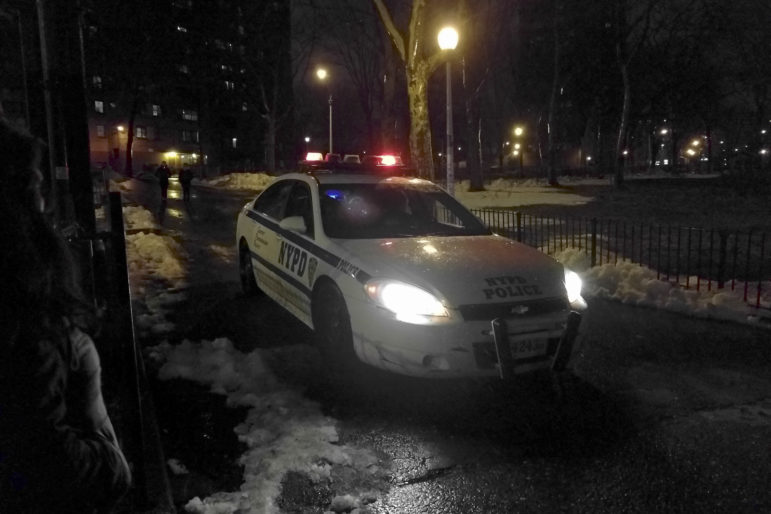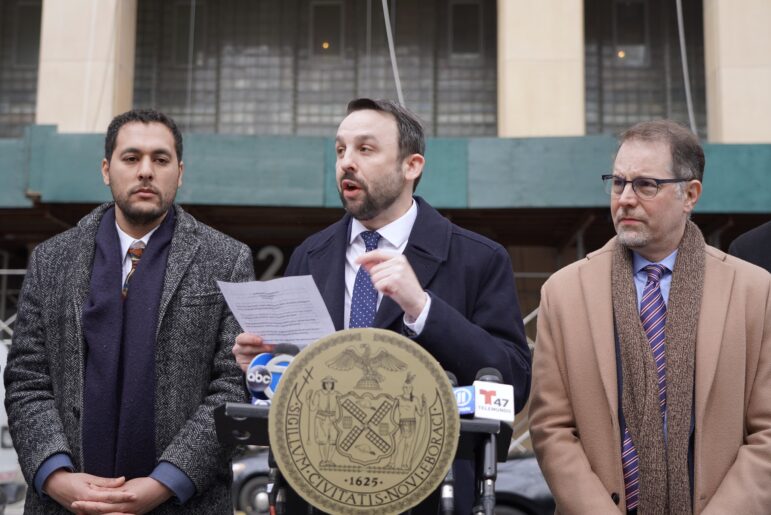
Ese Olumhense
A police car exits St. Mary’s Park Houses in the South Bronx. The area is served by NYPD Police Service Area (PSA) 7.
Jaswa and others blame the dropoff in applications on the overall difficulty they say is associated with filing a successful transfer application. So do some NYCHA tenants. After a family member was shot in the lobby of their building in 2014, one South Bronx family chose not to apply because they worried the process might take too long, with no guarantee they would be placed in a safer location. They saved up and moved into private housing instead. Others say they were misinformed about the program and its requirements by NYCHA staff members, causing unexpected denials. A Brooklyn mother, who needed stitches and a blood transfusion after a former partner slashed her face, neck, and back several times with a meat cleaver — in front of her children — tells City Limits she was denied a transfer because although she applied just before the perpetrator left prison, the incident happened more than a year before she submitted her application, rendering her application invalid because of a rule she says she was not aware of. She eventually moved in with a family member who lived in private housing.
But it’s unclear why the number of applications is dropping now: Jaswa says the emergency transfer process has historically been difficult to navigate for most residents. Outside of the two-incident rule, which Jaswa says posed “really burdensome” documentation requirements on applicants, applications could only be completed in paper form, which sometimes resulted in lost paperwork and delayed processing times, tenants say. At least one tenant who unsuccessfully applied for more than one emergency transfer says that when she went to her building management office to request her file and see what might have been delaying her requests, she was told that her file was lost.
NYCHA makes some changes
In response to our request for a comment, a NYCHA spokesperson declined to be interviewed, but sent a statement defending the emergency transfer program and answering some questions about the program via email.
“We work diligently to accommodate emergency transfers as quickly as possible and are committed to better serving the one in 14 New Yorkers who live at NYCHA,” the agency’s official statement read. “NYCHA’s mission is to provide deeply affordable housing and we strive to make our communities safe and secure for all of our residents.”
Over the years, in the face of criticism, NYCHA has implemented reforms to the program to streamline its handling of emergency transfer requests, including implementing a productivity reporting system to “more effectively manage caseloads and ensure the timely disposition of cases,” the agency said in an annual report earlier this year. NYCHA has also set a 45-day target for informing applicants of transfer request decisions, a goal it generally meets. In October 2014, NYCHA removed the two-incident requirement for some victims of domestic violence requesting transfer, a change that may have been the cause of an increase in approval rates of 26.3 percent for those applicants the following year, from 441 in 2014 to 557 in 2015.
But the spokesperson acknowledged that quickly finding apartments for applicants is a major challenge, and blamed the agency’s low vacancy rate. “Of NYCHA’s 177,000 units, less than one percent is vacant [sic], which is the biggest obstacles [sic] to accommodating transfer applications,” she wrote. “The Authority is unfortunately limited in its ability to provide broader options to residents,” she added.
In addition, the spokesperson wrote in an email, the authority has been working to ensure vacant units are back on the rent roll as soon as possible, and its officials conduct a review of vacant units each month to ensure timely completion of projects. The spokesperson said the agency did not have any data on why emergency transfer requests are falling, even as crime rises.
Citing privacy concerns, NYCHA repeatedly declined City Limits’ requests for data that would illuminate the reasons for denials. Nor did the spokesperson respond when asked to explain why specific applications were denied and whether the two-incident rule was a factor in the historically high rate of emergency transfer denials for scared victims of crime. But the spokesperson said in an email that NYCHA changed this rule in order to comply with a new directive from the U.S. Department of Housing and Urban Development, requiring that crime victims seeking emergency transfers no longer be asked to prove that they were the victims of two different criminal incidents.
Listen here.
When asked what residents who have been denied because of the now-defunct two-incident rule can do to appeal the agency’s decision, the spokesperson wrote, “Resident safety is the top priority for NYCHA and the authority does its best to ensure resident needs are accommodated as quickly as possible,” the spokeswoman wrote in an email. “If a resident’s emergency transfer request is not approved, the tenant receives information on how to file a grievance.”
The spokesperson did not respond to City Limits’ question about whether an emergency transfer denial had ever been changed to an approval because a grievance was filed.
Since changing the emergency transfer program in June, NYCHA has not updated the information about the program on its website. But in her email, the spokesperson wrote that another change that NYCHA made in mid-June addresses some of the difficulties of finding a safe place to transfer. Now applicants can exclude up to two ZIP codes in locations where they would feel unsafe. And those approved for transfer may now choose to be on a city-wide waiting list, when previously they could only select a particular borough.
In addition, NYCHA tenants can now apply for transfer online, the spokeswoman wrote, a move that should help prevent applications from getting lost.
The impact of a wait
Waiting a long time for an emergency transfer is stressful, says Tevina Willis, a former NYCHA liaison and community organizer for the office of City Councilman Antonio Reynoso, and a resident of Red Hook Houses. During outreach events and visits to NYCHA sites within the Brooklyn community where she worked, Willis says, she sometimes heard complaints from residents about the emergency transfer application process.
The program is “bad for a lot of people,” she says. “Let’s start with the word ‘emergency’ itself. The definition of emergency in NYCHA is different from what you or I would consider an emergency. When you’re in danger and urgently need help, six months is a long time to be looking over your shoulder and holding your breath.”
The Thomas Jefferson Houses is a NYCHA development in East Harlem, one of 24 NYCHA developments in the neighborhood. Khala Smith moved in there in the mid-1990s and raised seven of her eight children there. In the summer of 2005, her youngest son, then 15, was punched in the face by another man in “Jeff.” When Smith went to her management office seeking an emergency transfer, she was told she needed two criminal incidents to qualify. Later that same day, a Monday, she says, her eldest son was shot five times during an incident in the project. The Smiths, now a family of repeat victims, again asked for an emergency transfer. NYCHA later denied their request, Smith says, telling her the incidents needed to be related to qualify the family as intimidated victims.
After repeated inquiries (and intervention from a social worker) Smith said the family was offered a transfer to a development in Far Rockaway. She considered it, despite the distance from the kids’ schools, until she was told by a policeman she knew that the offer was in a location with worse crime than where she was currently living. She turned it down.
She panicked daily, worried that she made the wrong choice. Soon she began tracking crime in Jeff on a calendar on her fridge. When she would see or hear something in the neighborhood from their first floor apartment, she would mark the date with red pen. As time went on, she says, the calendar grew full of red ink, and soon the dates began to bleed together.
The family’s issues continued. Before long, Smith’s youngest son was stabbed twice in the project’s courtyard. She didn’t apply for a transfer then, because, she says, she didn’t think NYCHA would approve her.
A transfer to a safe neighborhood, Smith tells City Limits, might have keep that same son from later being shot in Jefferson Houses in July 2011. While heading to the store with friends, the then-21-year-old was struck by a tempest of bullets: one in his right hand, one in the back, another in the head, grazing his ear, two in the neck, and one in the chest, splitting it open. It is not clear whether that attack was related to the earlier one on that son.
After the incident, her son spent two months in the intensive care unit at Harlem Hospital. One of his lungs had collapsed, and he had needed a blood transfusion. His collarbone was shattered. The bullet that entered his chest was lodged in his rib. Surgeons at Harlem Hospital, who specialize in bullet trauma, feared that removing it would be too risky, so it remains there. The wound behind his right ear refused to clot, and would often open without notice, leaking blood down his neck.
Six years later, Smith’s youngest says he hasn’t felt well since that July evening. His family still holds NYCHA responsible for not relocating them to a safer neighborhood, though his mother is thankful that, unlike others in the project, he is still alive.
“To hell with Housing,” Smith says. “I hope I hit the Mega Million and can buy a house, and get the hell up out of Housing.”
Witness for the prosecution
The first time that the man who was arrested and charged with shooting Castillo’s neighbor went to trial, his case ended in a mistrial, after one of the jurors was seen talking to a member of the defendant’s family. But in 2014, he was convicted of criminal possession of a weapon and attempted assault, and sentenced to a minimum of six years in state prison. As of July 2017, his projected release date is November 2018.









One thought on “NYCHA Crime Witnesses Face Obstacles When They Seek Safety”
I have a son, & daughter-in-law, & numerous friends who work for NYCHA. I have observed from up-close the dangers, & hazards facing NYCHA employees DAILY, yet now, you expect them to continue to do the work with less resources, ARE YOU SERIOUS!!! NYCHA ranks right next to the Department of Sanitation as one of the dirtiest jobs, what with having to deal with vermin, (live & dead), vomit, feces, (of both the animal & human kind), toxic waste, filthy areas where they eat, having to enter into apartments that one would have to see to believe that tenants live in, drugs, etc. It is inhumane for both tenant & workers!!! As if that weren’t enough. we now have Mr. Ben Carson, who has been appointed to head NYCHA, who has absolutely “NO EXPERIENCE”, calling the shots. It’s demoralizing for the workers & adds “insult to injury”!!
Just picture for a moment, city without Sanitation, or, NYCHA to clean your filthy buildings?!! Let’s not forget that you are knowingly allowing tenants, calling special attention to children & animals, to live in inhumane conditions, allowing poor responses for repairs for months, while allowing politicians to lobby for gentrification, while tenants languish in filthy conditions. You are using re-zoning to displace hundreds, so, that you can sell them to the wealthy, who will receive all the financial assistance & convert these same filthy dwellings into beautifully restored apartments, complete with new trees, & playgrounds. Those poor living there currently apparently are not worthy of such treatment. You all forget, that God is watching & He Will Make It Right for All His Children!!